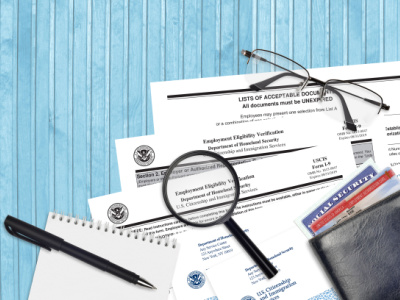On August 1, 2023, the Department of Homeland Security (DHS) published a revamped and streamlined Form I-9, which must be used starting November 1. The biggest change, however, is DHS’s creation of an “alternate procedure” that will make it easier for employers to inspect an employee’s work authorization documents. In lieu of a physical document examination, the alternative procedure allows certain employers to inspect documents by live video link provided the employer uses E-Verify and satisfies other criteria.
New Form I-9
In what appears to be an attempt to simplify the I-9 Form, DHS has consolidated section 1 (employee information and attestation) and section 2 (employer review and verification) onto a single page. Notably absent is the often-overlooked preparer and/or translator box that used to appear below Section 1.
Previously, employees were required to check “Yes” or “No” to indicate whether the employee received assistance from a preparer or translator to complete the Form I-9. If so, the preparer or translator had to provide their details.
In many instances however, employees who didn’t use a preparer or translator simply skipped the section entirely after only reading the section header. Therefore, the employee failed to check “No,” resulting in a technical violation upon an audit by U.S. Immigration and Customs Enforcement (ICE).
DHS has now relegated the preparer and/or translator portion to a separate standalone document identified as “Supplement A.” Supplement A needs to be completed only if the employee used a preparer or translator. This adjustment should reduce instances of nonsubstantive errors that could be attributed to the prior form’s formatting.
Another big change is moving section 3 to a separate standalone document identified as “Supplement B.” Reverification and rehire must be completed when the employee requires reverification. The portion may be completed when the employee is rehired within three years of the date the original Form I-9 was completed or provides proof of a legal name change. DHS’s shifting of section 3 to a supplemental document allowed it to reduce the Form I-9 to a single page for ease of use, thereby cutting down on the amount of unnecessary paper employers would need to retain.
There are several other subtle, yet important, differences to the new Form I-9. Starting November 1, employers that fail to use the 08/01/23 edition Form I-9 may be subject to penalties under section 274A of the INA, 8 U.S.C. 1324a, as enforced by ICE. Therefore, you should consider thoroughly reviewing the new form ahead of that deadline to ensure staff are prepared for the switch.
Alternative Procedure
Perhaps the most welcome change yet in the Form I-9 world is DHS’s announcement that E-Verify employers “in good standing” may remotely examine work authorization documents, effective August 1, 2023. To use this alternative procedure, a qualified employer must:
- Examine copies (front and back, if the document is two-sided) of Form I-9 documents or an acceptable receipt to ensure the documentation presented reasonably appears to be genuine.
- Conduct a live video interaction with the individual presenting the document(s) to ensure the documentation reasonably appears to be genuine and related to the individual. The employee must first transmit a copy of the document(s) to the employer (per step 1 above) and then present the same document(s) during the live video interaction.
- Indicate on the Form I-9, by completing the corresponding box, that an alternative procedure was used to examine documentation to complete section 2 or for reverification, as applicable.
- Retain, consistent with applicable regulations, a clear and legible copy of the documentation (front and back if the documentation is two-sided).
- In the event of a Form I-9 audit or investigation by a relevant federal government official, make available clear and legible copies of the identity and employment authorization documentation presented by the employee for document examination in connection with the employment eligibility verification process.
Other notable points include:
- Qualified employers using the alternative procedure must do so consistently for all employees at that site.
- Qualified employers may choose to offer the alternative procedure to remote hires only and still retain the ability to conduct physical inspections for onsite hires.
- Those qualified employers that were enrolled in E-Verify during the COVID-19 temporary flexibilities and created an E-Verify case for an employee (except for reverification) whose documents were inspected remotely can use the alternative procedure to satisfy the requirement to physically examine documentation by August 30.
Benjamin A. Nucci is an attorney with Snell & Wilmer LLP in Phoenix. You can reach him at bnucci@swlaw.com.

